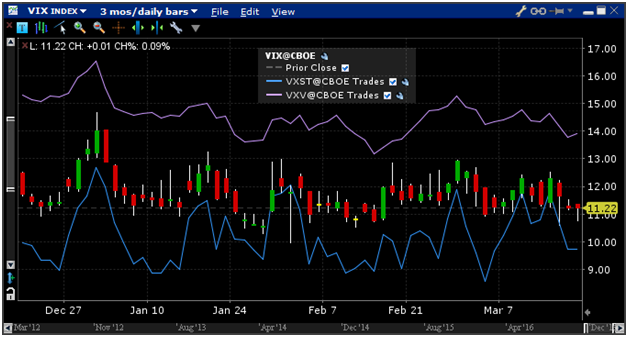At the close of today, the VIX finished at 11.23%, so on the surface everything seems to be calm and normal. However, the low VIX is making some investors nervous.
Why is the VIX so low?
In this post Dani Burger , Cecile Vannucci , and Liz McCormick cited some reasons for the low VIX:
- The VIX index is a function of realized volatility, and it has been low for a while
- Stock correlations are falling
- Traders are selling risk premium in the search for extra yields
- The perceived calm can be due to improving economic expectations

VXST, VIX and VXV as at march 17, 2017. Source: InteractiveBrokers
These views were shared early this month by James Butterfill at ETF Securities as he pointed out the reasons for the low VIX:
- Unstable macro events, a broad rise in the S&P 500 is masking unusually low correlation between market sectors and individual stocks. Though this does not fully explain why the VIX has been deviating from our model, as this is a recent phenomenon.
- CFTC futures on the VIX highlight much higher net positioning volatility; this has persisted since Ben Bernanke’s speech discussing tapering of quantitative easing in May 2013. It suggests increasingly divergent views on volatility.
- An increase in demand for financial products that promise protection from rises in the VIX and market volatility. We have seen a large rise in shares outstanding for long VIX ETFs, while short VIX ETFs shares outstanding have fallen commensurately.
- Conversely, low interest rates and the consequent hunt for yield from investors has led some investors to short the VIX, to take advantage of positive yield generated from the persistently steep term structure.
- We believe the VIX is artificially low because of CFTC positioning, while being volatile, it shows investors are close to the largest net short position in history. Read more
However, recently Marko Kolanovic at JPMorgan warned of an incoming near term market volatility. He noted that there are 2 main reasons for a potential increase in volatility:
- The first is a technical adjustment in fund flows resulting from monthly and quarterly options roll rebalancing.
- The second issue is more nuanced and involves global concerns. Read more
But he also suggested that investors should buy on the dip, if such a correction occurs, because he anticipated a quick V shape rebound.
Further questions
What's your question? Ask it in the discussion forum
Have an answer to the questions below? Post it here or in the forum




